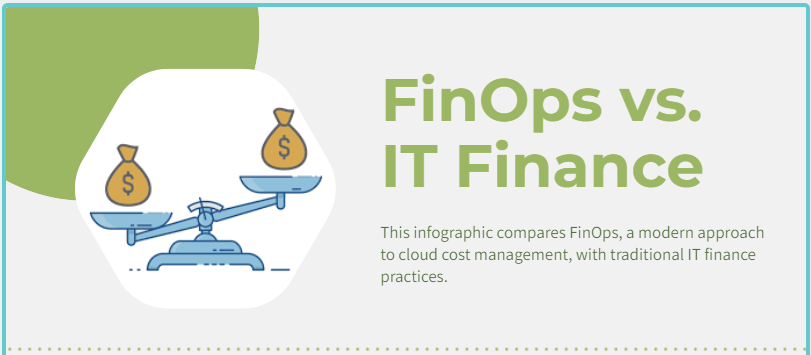FinOps goes beyond traditional IT finance by integrating finance into every stage of cloud operations, ensuring that cost considerations are part of the engineering and operational decision-making processes.
FinOps is more of a cultural practice that promotes shared responsibility for cloud cost management among IT, DevOps, finance, and other cross-functional teams in order to improve decision-making and drive greater business value (Daffodil Software) but has its own demerits.
First lets see an in-depth comparison.
FinOps vs Traditional IT Finance at a Glance
Why FinOps Implementation?
Implementing FinOps in your organization provides several key benefits that can significantly impact your bottom line. FinOps provides cost visibility, detailed reporting and analysis, optimization recommendations, budgeting and forecasting, as well as policy enforcement. This leads to better accountability, transparency, collaboration, agility, and informed decision-making.
The advantages of adopting FinOps are illustrated well through the cost savings that companies can achieve. Analysts at McKinsey estimate that organizations using FinOps can reduce cloud costs by up to 30%, contributing to increased ROI through better decision-making.
To master the various strategies for implementing FinOps successfully, check out our articles on the finops framework and finops lifecycle.
Key Challenges in FinOps Adoption
Adopting FinOps, or Financial Operations, within an organization can present various challenges. These hurdles need to be identified and addressed to effectively manage cloud costs and align financial strategies with operational goals.
Lack of Awareness and Education
A primary challenge in transitioning to FinOps is the lack of awareness and education. Many organizations exhibit a siloed organizational structure, which hampers effective FinOps implementation.
This decentralized nature of decision-making often leads to disjointed processes, lack of collaboration, and inefficient resource utilization. Overcoming this challenge involves:
- Educating team members about what is FinOps and its benefits.
- Restructuring teams to promote cross-functional collaboration.
- Appointing FinOps champions within the organization.
- Promoting transparency to align financial goals and improve cloud management efficiency.
Siloed Organizational Structure
The segmented nature of many companies poses a significant barrier to FinOps adoption. Disconnected departments make it difficult to coordinate financial and operational goals. This can lead to misaligned priorities and inefficient cloud resource utilization.
| Challenge | Solution |
|---|---|
| Lack of collaboration | Promote cross-functional team structures |
| Disjointed processes | Implement FinOps framework |
| Inefficient resource utilization | Foster communication channels and shared visions |
| Decentralized decision-making | Establish centralized financial and operational goals |
For more strategies, visit our page on promoting collaboration across teams.
Complexity of Cloud Cost Management
Managing cloud costs is inherently complex due to factors like pricing models, resource utilization, and service dependencies. This complexity can lead to budget overruns, overspending, and inefficient resource allocation if not managed properly.
Organizations can address this challenge by:
- Investing in specialized cloud cost management platforms.
- Establishing clear processes for cost management.
- Leveraging automation and analytics to optimize spending.
- Implementing multi-cloud tagging best practices to track and manage resources effectively.
For more insights, visit our article on 10 cloud cost reduction strategies.
Cultural Resistance to Change
Cultural resistance is a notable obstacle when implementing FinOps. Employees, stakeholders, or executives may resist changing established practices, hampering the adoption of FinOps principles.
To overcome cultural resistance:
- Communicate the benefits and importance of FinOps clearly and effectively.
- Conduct educational sessions to enhance understanding and buy-in from all levels.
- Promote a culture of innovation and continuous improvement.
- Recognize and reward adoption of FinOps practices.
For a detailed guide, check out finops principles.
Addressing these key challenges in FinOps adoption is crucial for successfully managing your organization’s cloud costs and aligning financial strategies with operational objectives. For further reading on this topic, explore our resources on cloud budgeting and forecasting, chargeback and show-back models, and rightsizing cloud resources.
Strategies for Successful FinOps Implementation
Implementing FinOps effectively within your organization requires a strategic approach to ensure success. Here are key strategies to consider:
Promoting Collaboration Across Teams
In FinOps, collaboration between finance, engineering, and business teams is vital. This promotes accountability and enables informed decision-making, driving efficiency in cloud cost management. Ensuring clear communication and shared goals across these teams can help in overcoming the traditional siloes that often hinder cost optimization efforts.
Investing in FinOps Tools
Utilizing dedicated FinOps tools can greatly enhance your cloud financial management. Tools like NetApp’s Spot, which has achieved FinOps Certified Platform certification, provide essential capabilities for managing cloud costs efficiently.
IT Financial Management (ITFM) tools like Nicus integrate various data sources to offer a comprehensive view of cloud consumption and expenses, enabling more informed decision-making.
Establishing Clear Processes
Adopting clear and effective processes is crucial for FinOps success. According to analysts, companies can reduce cloud costs by up to 30% using FinOps principles, which include cross-team collaboration, real-time decision-making, ownership, and accountability (XenonStack).
However, only 15% of companies understand the unit economics of their cloud usage, causing unexpected costs. Developing a structured approach that aligns with these principles can help maximize cloud investment value.
Leveraging Automation and Analytics
Automation and analytics play a crucial role in optimizing FinOps practices. Automation enhances cloud financial management by driving efficiency, accuracy, and scalability (Daffodil Software).
Additionally, automation solutions can analyze resource usage patterns to identify overprovisioned or underutilized assets, helping you right-size resources and eliminate waste (Daffodil Software).
By incorporating machine learning algorithms and historical data, these tools can provide actionable insights to reduce unnecessary costs. Adopting these strategies can transform your approach from traditional IT finance to FinOps, ensuring that your organization not only controls cloud costs but also aligns financial strategies with operational goals.
For further reading, you can explore articles on what is finops and 10 cloud cost reduction strategies.





